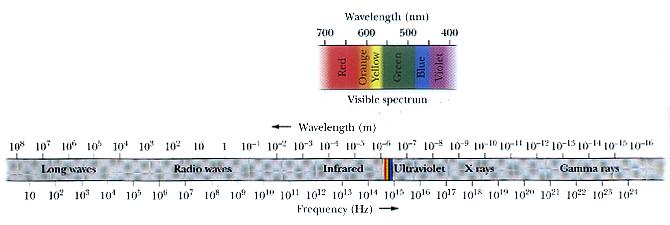Posted By: Rob Campbell, Grad student, Biological Oceanography, Dalhousie University
Area of science: Physics
ID: 910976130.Ph
Message:
Hello Phillip: A very good question! Before I get started, you should know a little bit about how light works. I'd recommend you try here first. Briefly, the light we can see is a small part of the electromagnetic spectrum, only a range of about 300 nanometers. In that range are the primary colors we can see: red, orange, yellow, green, blue and violet (see the attached picture). The way an object (or a fluid, or a gas, whatever) absorbs and doesn't absorb the different wavelengths of light affects what color it appears to us as. For instance, an object that absorbs light in the orange to violet wavelengths (say 400 to 650 nm), but not in the red wavelengths (say 650 to 700nm), will appear red to us. Since the light in the red wavelengths is not absorbed, it is bounced back to our eyes.
Now then, I'll assume that you mean water found in lakes and oceans. If you take "pure" water, that is to say water with absolutely nothing in it, it would appear blue to you (tap water is pretty clean, and usually has a blue-ish tint to it- check for yourself!). This is because water does not absorb blue light very well, and so it is mostly blue light that bounces back to your eyes. The water you typically see in lakes and the ocean is often green-ish. This is because of all the little things floating around in it. Most important are the "phytoplankton", which are one-celled plants ( click here for more on phytoplankton). Plants contain chlorophyll, which does not absorb green light very well. As above, green light is not absorbed by chlorophyll, so it is mostly what is bounced to your eye, making plants (and the water they're floating in) appear green. So, to summarize and get back to your original question- Water is heated by absorbing light radiation, from the sun. There are two basic colors of water you'll find in nature: there is "blue" water, which is water without much stuff in it, and there's "green" water, which is water with lots of little plants in it. So, if you take equal volumes of pure water and water with phytoplankton, and put them out in the sun, the water with phytoplankton in it (green water) will absorb the same amount of light as the pure water (blue water), plus all the little plants in the phytoplankton water will also be absorbing light energy too. This means that the water with the phytoplankton in it (the green water)will absorb more light energy, and become hotter.
